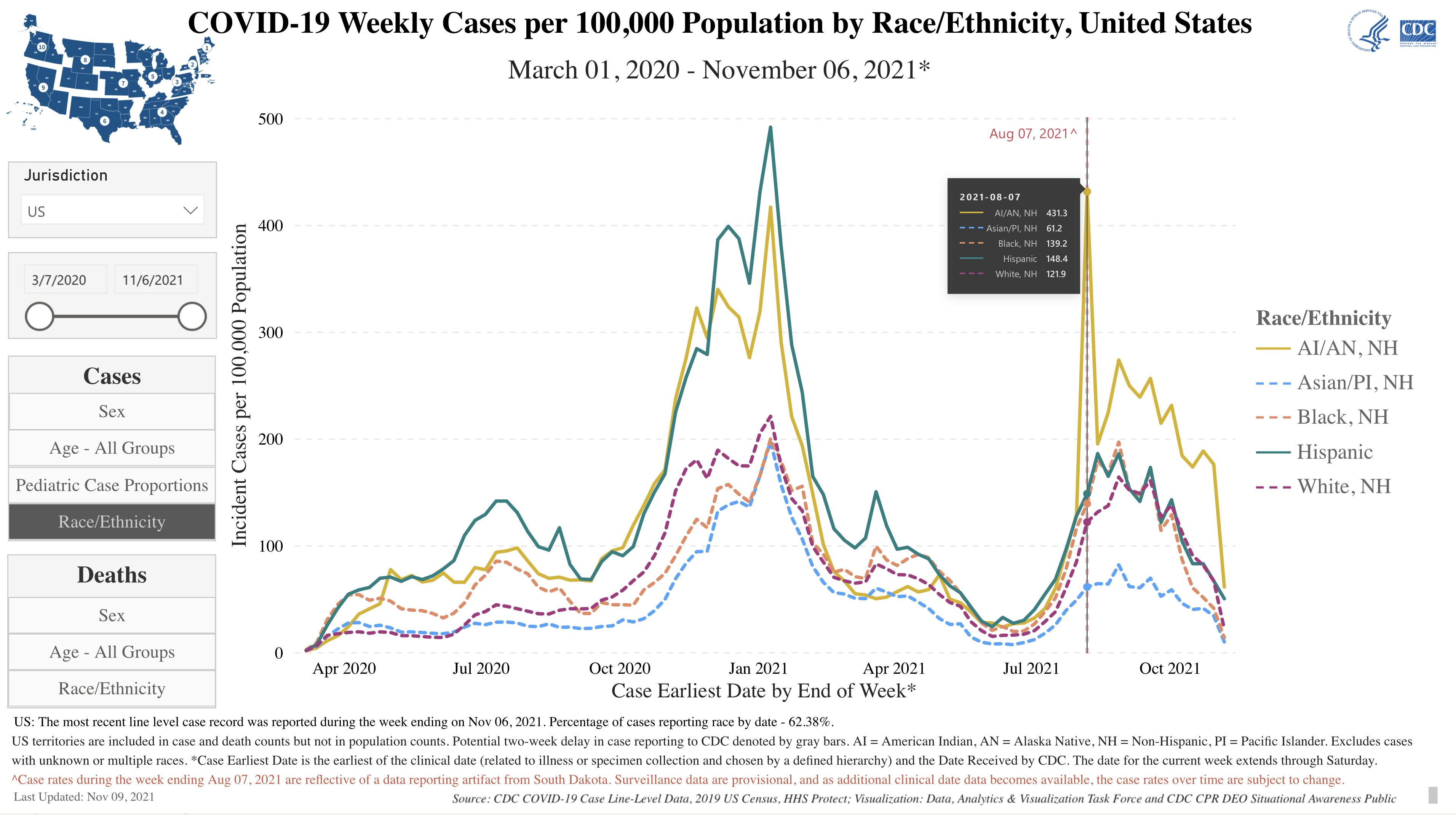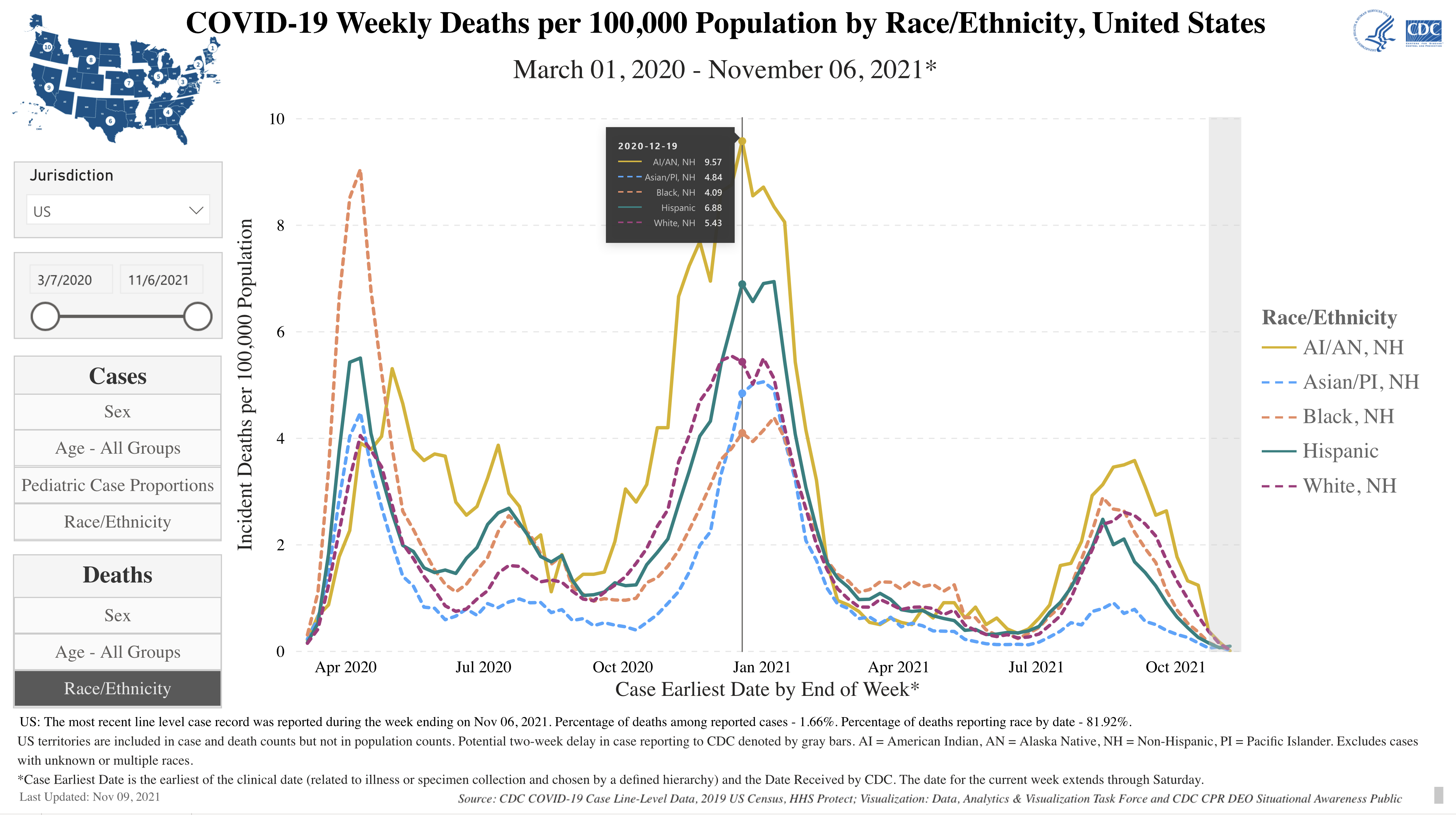Indianz.Com > News > ‘A long journey’: Indian Country continues to suffer from COVID-19
‘A long journey’: Indian Country continues to suffer from COVID-19
Tuesday, November 9, 2021
Indianz.Com
The Indian Health Service has begun rolling out COVID-19 vaccines for youth as the coronavirus continues to have an outsize impact on Indian Country more than 18 months into the pandemic.
On Monday, the Anadarko Indian Health Center in Oklahoma administered the first doses of the COVID-19 vaccine to youth between the ages of 5 and 11. Officials hailed federal authorization as a key step in the ongoing fight against the coronavirus, which has affected American Indians and Alaska Natives at disproportionate levels.
“It’s been a long journey to get here,” Elizabeth Fowler, the acting director of the IHS, said during a media event at the facility. “We are one step closer to reaching community immunity with the recent authorization of the Pfizer COVID-19 vaccine for children ages 5 to 11.”
Fowler, a citizen of the Comanche Nation, was joined by tribal leaders who also welcomed the approval of the COVID-19 vaccine for young people in their communities. With schools returning to in-person classes, Native youth have been at heightened risk for contracting and transmitting the disease, sometimes to devastating outcomes. “I just recently had my own granddaughter, who caught COVID from a school teacher,” said Bobby Gonzalez, the chairman of the Caddo Nation. While youth tend to experience less severe illness after contracting the coronavirus, the same cannot always be said for adults in their homes. Gonzalez disclosed that he recently lost two family members to COVID-19, which has killed American Indians and Alaska Natives at the highest rates in the nation. “Her grandson brought COVID-19 home,” Gonzalez said of his sister. “She made it for about a month.” “She passed away, which was devastating to our own family, as well as most families that had these types of losses,” the chairman said. “It’s not our first loss. We’ve been devastated as a community,” Gonzalez added. A brother also contracted COVID-19 at around the same time, he said. “We buried them both the same on the same day,” Gonzalez said. “So this is real.” The Oklahoma City Area of the IHS in fact has been one of the hardest hit by COVID-19, even after the widespread availability of the vaccine. The region, which serves all of Oklahoma, the state of Kansas and portions of Texas, has endured the highest coronavirus positivity rates it has seen since the onset of the pandemic in early 2020. Throughout August and September, the Oklahoma City Area consistently ranked as the IHS region with the highest or second-highest rate of COVID-19 positivity, which is defined as the number of coronavirus tests that return positive during a seven-day span. The development was a dramatic one, as tribal communities in the region had not previously experienced such a surge. Terri Parton, the president of the Wichita and Affiliated Tribes, perhaps offered an explanation for the trend. She admitted that she waited until September to get the COVID-19 vaccine, and it was only after her 15-year-old nephew contracted the disease. “He got tested and he had COVID,” Parton said at the media event. “One of the nurses came out from here at the clinic and was talking to me about the vaccine, and kind of talked me into it.” COVID-19 positivity rates have finally fallen in the Oklahoma City Area, according to more recent data from the IHS. But federal officials couldn’t fully explain why the region underwent such a significant surge, followed by an apparently flattening of the coronavirus. After being asked by Indianz.Com during the media event to provide more details about COVID-19 in Oklahoma, Fowler passed the question to Travis Watt, who serves as the director of the Oklahoma City Area of the IHS. He characterized the trends seen over the last few months as a natural occurrence of the pandemic. “We’ve had kind of dramatic spikes,” said Watt, who is a citizen of the Choctaw Nation. “We’ve had dramatic increases and dramatic decreases. But it seems like it’s over a week, we’ll see these spikes start to trend down.” When asked by Indianz.Com whether the IHS has taken any steps to reduce COVID-19 positivity rates in the region, Watt did not offer any specifics from the agency’s standpoint. While he acknowledged that more patients have been seeking out the vaccine, he returned to the idea that other regions of Indian Country are expected to see similar spikes in the coming weeks. “It sounds counterintuitive, but when you have the spikes and the variant increases, we also have an increase in vaccination,” said Watt. “So we think of course, vaccinations play a part of it but we also think it’s also part of the natural progression of the pandemic.”IHS Acting Director Elizabeth Fowler visited the Anadarko Indian Health Center in Oklahoma today as they began administering #COVID19 vaccines for children 5-11 years old. This is a significant step in the fight against COVID-19, bringing us closer to reaching #CommunityImmunity. pic.twitter.com/yXrktJoGrW
— IndianHealthService (@IHSgov) November 8, 2021
Data released by the IHS on Monday shows how other regions are in fact seeing higher COVID-19 positivity rates. For example, the Phoenix Area, the Navajo Area and the Tucson Area, all of which include the state of Arizona, are now among the hardest hit by new infections, according to the agency. So with Indian Country continuing to suffer from the coronavirus, Watt stressed the need for tribes and their citizens to remain vigilant about the spread of the disease. “The leadership that we have within the Indian communities — about social distancing and practicing hand washing — all those things come into play when it comes to the reduction of the pandemic,” Watt said at the health center in Anadarko. According to the Centers for Disease Control and Prevention, American Indians and Alaska Natives have experienced the highest infection, hospitalization and death rates, when compared to other racial and ethnic groups. During the media event on Monday, the IHS cited the disparities in encouraging more Native people to get vaccinated against COVID-19. “We know American Indians and Alaska Natives have had the highest hospitalization and death rates from COVID-19,” said Greggory Woitte, the chief medical officer for the Oklahoma City Area of the IHS. “Getting vaccinated with one of our three safe and effective vaccines is the best way to prevent this.”As of November 7, 2021, 11 of 12 Indian Health Service areas have high #COVID19 positivity rates:
— indianz.com (@indianz) November 8, 2021
Phoenix—15.3% of tests positive
Navajo—13.9%
Billings—13.7%
Tucson—13.2%
Bemidji—12.7%
Great Plains—9.3%
Albuquerque—8.9%
Alaska—7.6%
California—6.5%
Nashville—6%
Oklahoma City—5.5%
CDC Data: COVID-19 Weekly Cases and Weekly Deaths
COVID-19 cases and deaths among American Indians and Alaska Native have been the highest in the nation, according to the Centers for Disease Control and Prevention. The highest weekly case rate was seen on August 7, 2021, long after the widespread availability of the COVID-19 vaccine. The highest weekly death rate was reported on December 19, 2020, and has not been surpassed, the data shows.


As of November 8, the IHS has administered more than 1.46 million doses of the COVID-19 vaccine. Among the 12 regions of Indian Country, the Oklahoma City Area accounts for the largest number of doses administered, as well as distributed, the data shows. Nationally, American Indians and Alaska Natives have achieved the highest vaccination rates among all racial and ethnic groups, according to the CDC. As of November 8, 58.8 percent of Native people have received at least once COVID-19 dose, the highest rate in the nation. Additionally, 50.2 percent are fully vaccinated, which again is the highest rate in the United States. American Indians and Alaska Natives, however, account for a small percentage of the overall population of the U.S. “I really stress to our Indian communities,” said President Parton of the Wichita and Affiliated Tribes said on Monday, “that you get the vaccination to help protect your elders and your children.”
Search
Filed Under
Tags
More Headlines
Cronkite News: Long COVID cases remain high in Arizona
Native America Calling: Eyes in the sky for development, public safety, and recreation
Native America Calling: Three new films offer diverse views of Native life
NAFOA: 5 Things You Need to Know this Week
Chuck Hoskin: Cherokee Nation works toward cure for arthritis
Native America Calling: Protecting young people from the down sides of social media
Cronkite News: Fake ‘shaman’ among candidates failing to make Congressional ballot
Native America Calling: New Native voices in poetry
Cronkite News: Tribes air concerns about border at hearing in nation’s capital
Native America Calling: Indiginerds descend on Oklahoma City
Native America Calling: Political leaders target tribes with unfounded claims
Cronkite News: First Native woman in space shares unique journey
Native America Calling: Tackling a troubling trend for Native women in prison
Chuck Hoskin: Cherokee Nation safeguards our Native language
Native America Calling: How will $1.5 billion in opioid settlement money help the populations hit the hardest?
More Headlines
Native America Calling: Eyes in the sky for development, public safety, and recreation
Native America Calling: Three new films offer diverse views of Native life
NAFOA: 5 Things You Need to Know this Week
Chuck Hoskin: Cherokee Nation works toward cure for arthritis
Native America Calling: Protecting young people from the down sides of social media
Cronkite News: Fake ‘shaman’ among candidates failing to make Congressional ballot
Native America Calling: New Native voices in poetry
Cronkite News: Tribes air concerns about border at hearing in nation’s capital
Native America Calling: Indiginerds descend on Oklahoma City
Native America Calling: Political leaders target tribes with unfounded claims
Cronkite News: First Native woman in space shares unique journey
Native America Calling: Tackling a troubling trend for Native women in prison
Chuck Hoskin: Cherokee Nation safeguards our Native language
Native America Calling: How will $1.5 billion in opioid settlement money help the populations hit the hardest?
More Headlines